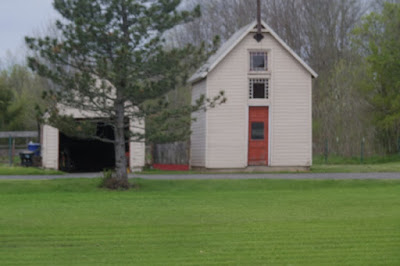Every year, fourth graders from three of Grand Island’s schools take a bus tour of Grand Island. The tour is organized by the Grand Island Historical Society. It is a highlight of the year for both the fourth graders and for the historical society. As a member of the historical society, I was able to join the tour with fourth graders and their teachers from Huth Road Elementary School. The tour was fascinating and much information was shared with the students and the teachers.
Here are some of the highlights of the tour:
the SS Corona was a wooden steamship that transported people from Buffalo to the “picnic groves” of Grand Island. They included Edgewater, Eagle Park, and Electric Beach. The steamship had been launched in Manitowoc, Wisconsin, on September 25th, 1869. Its history included transporting passengers and freight on Lake Michigan, carrying passengers from downtown Buffalo to Woodlawn Beach, and transporting people from Buffalo to Grand Island. The ship caught on fire when it was docked at the Edgewater Hotel on November 18th, 1898, and it burned to the waterline. In this picture, you can see pieces of the ship’s machinery that jut from the water. The cause of the fire was listed as “suspicious.”
store’s lettering remains on the front windows. In the past, it was a dry goods
store, with the only gas pump in the area. From 1938 until 1948, it also served
as the town’s post office. The postmaster was Harry Tucker.
 the Davern House: this was a Victorian house that was built at about 1900. Some of the features of the house include lion heads, an octagonal turret with five windows and a ten foot high ceiling. It also sports two trap doors in the house. The stories are that the trap doors were used to hide illegal alcohol during Prohibition.
the Davern House: this was a Victorian house that was built at about 1900. Some of the features of the house include lion heads, an octagonal turret with five windows and a ten foot high ceiling. It also sports two trap doors in the house. The stories are that the trap doors were used to hide illegal alcohol during Prohibition.
Highlights of River Lea:
the laundry skit: Maggie Gushue acts as a nineteenth century woman living on a farm. Laundry day occurred once a week and it was a huge chore. Everything was washed by hand, including sheets and stiff collars. Wet clothes had to be put through a wringer, as seen in the above photograph. Soiled clothing had to be scrubbed on a wash board. The iron had to be heated on the stove and it had to be exactly the right temperature or the clothing would either continue to be wrinkled or it would be scorched. All clothing had to be hung up to dry.
the morning dressing routine: Robin Shipman told her story.
Getting dressed was a challenging project for a lady in the nineteenth century. She had to put on a variety of undergarments before getting her dress on. These undergarments included a hoop, a corset to make her waist look very skinny, a bustle to make her derriere look larger, and more. Another interesting item was a pair of shoes. A woman simply had two shoes, which could be put on either foot. There was no such thing as a “left shoe” or a “right shoe.” These fashion statements sometimes caused problems for ladies. If the corset was tied too tight, the lady could faint from lack of oxygen.
the blacksmith shop:
Bryce Shipman demonstrated some of the work that was done on a farm, which including cutting down a tree with a two person saw, shaping a horseshoe, picking up hay with a pitchfork, and more.
A few more photographs:
 |
| The bus tour included Town Hall. Pictured above is Town Court Clerk Maria Burns, explaining how the court functions. |






